

Welcome to APS. Seed Sourcer. Propagating Plants By Grafting. [Continued From January Number.] By A. 8. Fuller. Roots are often used for stocks instead of the stems of plants.
![Propagating Plants By Grafting. [Continued From January Number.] By A. 8. Fuller](http://cdn.pearltrees.com/s/pic/th/propagating-grafting-continued-81429611)
Cions may be fitted to a root, or a section of one, in precisely the same manner as they are upon stems or branches. The mechanical part of the operation is very similar in both cases. Sometimes it is desirable to graft below the surface of the soil, that the cion may eventually take root and become capable of furnishing itself with sustenance from the earth instead of relying upon the original stock. In all cases where it is expected that the cions will emit roots, the junction should be made below the surface of the soil, at least so low that only the uppermost one on the cion shall be above the surface. Fig. 25 shows a common method of crown grafting below ground. Budding. Budding Budding is a grafting technique in which a single bud from the desired scion is used rather than an entire scion containing many buds.
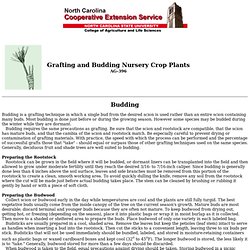
Most budding is done just before or during the growing season. However some species may be budded during the winter while they are dormant. Budding requires the same precautions as grafting. Be sure that the scion and rootstock are compatible, that the scion has mature buds, and that the cambia of the scion and rootstock match. Preparing the Rootstock Rootstock can be grown in the field where it will be budded, or dormant liners can be transplanted into the field and then allowed to grow under moderate fertility until they reach the desired 3/16- to 7/16-inch caliper. Graft of majorcan escutcheon: Grafting and Budding Nursery Crop Plants. Contents Introduction Grafting Budding SummaryAppendix Grafting and Budding Nursery Crop Plants Introduction Grafting and budding are horticultural techniques used to join parts from two or more plants so that they appear to grow as a single plant.
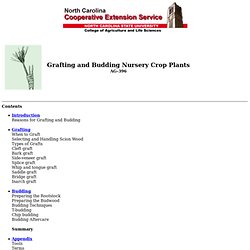
In grafting, the upper part (scion) of one plant grows on the root system (rootstock) of another plant. In the budding process, a bud is taken from one plant and grown on another. Although budding is considered a modern art and science, grafting is not new. Since grafting and budding are asexual or vegetative methods of propagation, the new plant that grows from the scion or bud will be exactly like the plant it came from. Most woody nursery plants can be grafted or budded, but both processes are labor intensive and require a great deal of skill. Grafting. Grafting When to Graft Unlike budding, which can be performed before or during the growing season, most grafting is done during winter and early spring while both scion and rootstock are still dormant.
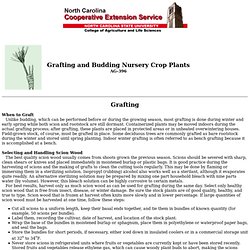
Containerized plants may be moved indoors during the actual grafting process; after grafting, these plants are placed in protected areas or in unheated overwintering houses. Field-grown stock, of course, must be grafted in place. Some deciduous trees are commonly grafted as bare rootstock during the winter and stored until spring planting. Indoor winter grafting is often referred to as bench grafting because it is accomplished at a bench. Selecting and Handling Scion Wood The best quality scion wood usually comes from shoots grown the previous season. Cut all scions to a uniform length, keep their basal ends together, and tie them in bundles of known quantity (for example, 50 scions per bundle). Propagation of Plants by Stem Cuttings - Rainyside.com. When we first become gardeners we rush out in spring to buy annuals in six packs and start a few seeds in the ground.
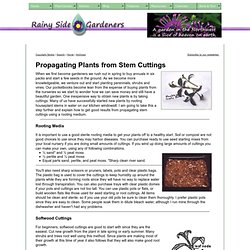
As we become more knowledgeable, we venture out and start planting perennials, shrubs and vines. Our pocketbooks become lean from the expense of buying plants from the nurseries so we start to wonder how we can save money and still have a beautiful garden. One inexpensive way to obtain new plants is by taking cuttings. Many of us have successfully started new plants by rooting houseplant stems in water on our kitchen windowsill. I am going to take this a step further and explain how to get good results from propagating stem cuttings using a rooting medium.
Rooting Media It is important to use a good sterile rooting media to get your plants off to a healthy start. Plant Propagation by Stem Cuttings: Instructions for the Home Gardener. G6970 Home Propagation of Garden and Landscape Plants. Reviewed by Christopher J.

Internationally Recognized 72 Hour Permaculture Design Certification Course. Located on a beautiful 360 acres in the foothills of the Rocky Mountains, we maintain a legacy of sustainability, organic farming and land stewardship since 1945.
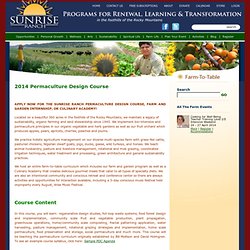
We implement bio-intensive and permaculture principles in our organic vegetable and herb gardens as well as our fruit orchard which produces apples, pears, apricots, cherries, peaches and plums. We practice holistic agriculture management on our diverse multi-species farm with grass-fed cattle, pastured chickens, Nigerian dwarf goats, pigs, ducks, geese, wild turkeys, and horses. We teach animal husbandry, pasture and livestock management, rotational and mob grazing, coordinated irrigation techniques, water treatment and processing, green architecture and general sustainability practices.
We host an entire farm-to-table curriculum which includes our farm and garden program as well as a Culinary Academy that creates delicious gourmet meals that cater to all types of specialty diets. Patrick Padden Joel Glanzberg Jason Gerhardt. Plants. Farming.